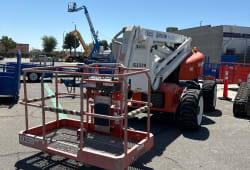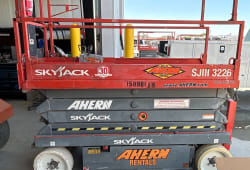Manual vs. Hydraulic Quick Couplers in Heavy Equipment: A Comparative Analysis
10 Min read
)
December 11, 2023
Manual vs. Hydraulic Quick Couplers in Heavy Equipment: A Comparative Analysis
In the world of heavy equipment, quick couplers play a crucial role in enhancing efficiency and productivity. These devices allow operators to switch between various attachments quickly and easily, saving valuable time on the job. However, there are two main types of quick couplers available for heavy equipment: manual and hydraulic. Understanding the differences between the two and their respective advantages and disadvantages is essential for making an informed choice. This article will provide a comprehensive comparative analysis of manual and hydraulic quick couplers, helping you choose the right option for your heavy equipment needs.## Understanding Quick Couplers in Heavy Equipment
Definition and Function of Quick Couplers
Before delving into the comparison, let's first clarify what quick couplers are and how they work. Quick couplers are mechanical devices designed to connect different types of attachments, such as buckets, grapples, or forks, to heavy equipment, such as excavators or loaders. Their primary function is to enable rapid attachment changeouts, replacing the need for manual attachment mounting and dismounting.
Quick couplers typically consist of a female receiver that is attached to the equipment and a male attachment that is connected to the tool. When the attachment is correctly aligned with the receiver, a locking mechanism secures them together, ensuring a safe and reliable connection.
But let's dive deeper into the inner workings of quick couplers. The female receiver is usually equipped with hydraulic cylinders that actuate the locking mechanism. These cylinders are controlled by the operator from the cab of the heavy equipment, allowing for quick and effortless attachment changes. The male attachment, on the other hand, features a series of pins or hooks that engage with the receiver, ensuring a secure connection.
It's worth noting that quick couplers come in different designs and configurations, depending on the manufacturer and the specific application. Some quick couplers use a hydraulic system to engage and disengage the attachment, while others rely on mechanical mechanisms such as levers or latches. The choice of quick coupler depends on factors such as the type of attachment, the weight capacity of the equipment, and the desired level of automation.
Importance of Quick Couplers in Heavy Equipment
The importance of quick couplers in heavy equipment cannot be overstated. They significantly increase operational efficiency and reduce downtime by eliminating the need for manual attachment changes, which can be time-consuming and labor-intensive. With quick couplers, operators can switch from one job task to another swiftly and seamlessly, maximizing productivity on the job site.
Furthermore, quick couplers enhance safety by eliminating the risks associated with manual attachment changes. By simplifying the process and reducing human involvement, the likelihood of accidents or injuries is significantly reduced.
But let's explore some additional benefits of quick couplers. One key advantage is the versatility they offer. With a quick coupler system, heavy equipment can be easily transformed into a multi-purpose machine. For example, an excavator equipped with a quick coupler can quickly switch from digging trenches to lifting heavy objects with a grapple attachment. This versatility allows contractors to take on a wider range of projects without the need for additional equipment.
Another advantage of quick couplers is their compatibility with various attachments. Manufacturers produce a wide range of attachments that are specifically designed to work with quick coupler systems. These attachments are engineered to seamlessly integrate with the quick coupler, ensuring a perfect fit and optimal performance. Whether it's a bucket for excavation, a brush cutter for land clearing, or a snowplow for winter maintenance, there's a quick coupler-compatible attachment available for almost any job.
Additionally, quick couplers contribute to cost savings in the long run. By reducing the time and effort required for attachment changes, operators can complete more tasks in a shorter amount of time. This increased efficiency translates to higher productivity and potentially more billable hours. Moreover, quick couplers minimize wear and tear on attachments and equipment, as they eliminate the need for repetitive manual mounting and dismounting. This reduction in wear and tear can extend the lifespan of both the attachments and the heavy equipment, resulting in lower maintenance and replacement costs.
In conclusion, quick couplers are essential components in heavy equipment, providing efficient and safe attachment changeouts. Their ability to enhance productivity, versatility, and cost savings make them a valuable investment for contractors and operators in various industries.
Manual Quick Couplers: An Overview
Manual quick couplers are an essential component of heavy equipment, allowing for efficient and convenient attachment changes. These couplers rely on a simple yet effective mechanism operated by the equipment operator. When it's time to change attachments, the operator manually aligns the male attachment with the female receiver and secures them together by activating a locking mechanism. This process requires the operator to exit the cab and physically engage with the attachment.
But what exactly makes manual quick couplers a popular choice among equipment operators? Let's delve deeper into their working principle and explore their pros and cons.
Working Principle of Manual Quick Couplers
The working principle of manual quick couplers is straightforward and user-friendly. By manually aligning and securing attachments, operators can swiftly switch between different tools and maximize their productivity on the job site. This versatility is a significant advantage of manual quick couplers, as they are generally compatible with a wide range of attachments.
Whether it's a bucket, a grapple, or a hydraulic hammer, manual quick couplers can handle various attachments, making them suitable for many heavy equipment applications. This adaptability ensures that operators can tackle different tasks without the need for additional equipment or time-consuming attachment changes.
Pros and Cons of Manual Quick Couplers
Manual quick couplers offer several advantages that make them a popular choice among equipment operators. Let's explore some of these benefits:
Cost-Effective: Manual quick couplers are generally more affordable than their hydraulic counterparts, making them an attractive option for cost-conscious individuals or companies operating on a tight budget. By choosing manual quick couplers, operators can enjoy the convenience of attachment changes without breaking the bank.
Simple and Reliable: The manual operation of these quick couplers makes them easy to use and less prone to mechanical failures or malfunctions. With fewer complex components, operators can rely on the simplicity and reliability of manual quick couplers to get the job done efficiently.
Versatile: With the ability to work with a wide variety of attachments, manual quick couplers provide versatility and adaptability on the job site. Operators can effortlessly switch between different tools, allowing for seamless transitions and increased productivity.
However, manual quick couplers also have their limitations and potential drawbacks. It's essential to consider these factors before deciding on the right coupler for your specific needs:
Limited Convenience: Since manual quick couplers require the operator to exit the cab for attachment changes, they can be less convenient and time-consuming compared to their hydraulic counterparts. This additional step of physically engaging with the attachment may result in slight delays in the workflow.
Increased Operator Effort: As manual quick couplers rely on the physical engagement of the operator, it can be more physically demanding, especially when working with heavy attachments or in challenging weather conditions. Operators need to exert more effort to align and secure the attachments, which can be tiring and potentially increase the risk of fatigue-related errors.
Despite these limitations, manual quick couplers remain a popular choice for many equipment operators due to their cost-effectiveness, reliability, and versatility. By understanding their working principle and weighing the pros and cons, operators can make informed decisions when selecting the right quick coupler for their heavy equipment.
Hydraulic Quick Couplers: An In-depth Look
How Hydraulic Quick Couplers Operate
Unlike manual quick couplers, hydraulic quick couplers are operated hydraulically, eliminating the need for manual intervention by the operator. Hydraulic circuits in the equipment provide the necessary power to engage or disengage the coupling mechanism with a simple switch or lever inside the cab.
Hydraulic quick couplers are designed for seamless attachment changes, allowing operators to complete the process without leaving the comfort and safety of the operator's cab.
Advantages and Disadvantages of Hydraulic Quick Couplers
Hydraulic quick couplers offer several advantages that make them appealing for specific applications.
Convenience and Efficiency: Hydraulic quick couplers enable operators to change attachments quickly and effortlessly from the comfort of the cab, eliminating the need for manual intervention.
Operator Safety and Comfort: By eliminating the physical effort and potential risks associated with manually engaging attachments, hydraulic quick couplers enhance operator safety and reduce fatigue.
However, hydraulic quick couplers also have some considerations to keep in mind.
Higher Cost: Hydraulic quick couplers are generally more expensive upfront compared to manual options. However, they can provide a good return on investment, considering the increased efficiency and productivity they offer.
Additional Maintenance: Hydraulic quick couplers require regular maintenance and periodic inspections to ensure proper functioning. Hydraulic systems can be more complex and delicate, requiring skilled technicians for servicing.
Key Differences between Manual and Hydraulic Quick Couplers
Performance Comparison
When it comes to performance, both manual and hydraulic quick couplers have their distinct advantages.
Manual quick couplers are known for their simplicity and reliability. They are suitable for various applications and ensure a secure attachment connection. However, they may not provide the same speed and convenience as hydraulic options.
Hydraulic quick couplers excel in terms of efficiency and convenience. With the ability to change attachments from the operator's seat, they offer significant time savings and increased productivity. Moreover, hydraulically operated couplers provide superior attachment engagement force, enhancing stability and precision during operation.
Cost and Maintenance Analysis
Cost is a significant factor when choosing between manual and hydraulic quick couplers.
Manual quick couplers are generally more cost-effective upfront, making them an attractive choice for those on a budget. The simplicity of their design also means they require minimal maintenance, reducing long-term costs.
On the other hand, hydraulic quick couplers have a higher initial price tag but offer increased efficiency and productivity. However, they require regular maintenance and periodic servicing to ensure optimal performance and longevity.
Choosing the Right Quick Coupler for Your Equipment
Factors to Consider When Selecting Quick Couplers
When deciding between manual and hydraulic quick couplers, several factors should be taken into account:
Application: Consider the specific applications and tasks your equipment will be performing. Evaluate the workload, attachment compatibility, and frequency of attachment changes.
Productivity Requirements: Assess the level of productivity improvement required and how much time can be saved with hydraulically operated quick couplers.
Budget: Consider your financial constraints and weigh the upfront cost against the long-term benefits.
Operator Preferences: Consult with equipment operators to understand their preferences and the impact on their comfort and safety.
Making the Decision: Manual or Hydraulic?
The choice between manual and hydraulic quick couplers ultimately depends on your specific needs and circumstances. While manual options offer simplicity, versatility, and cost savings, hydraulic solutions provide convenience, efficiency, and improved operator comfort.
If your operations involve frequent attachment changes and require utmost efficiency, a hydraulic quick coupler may be the ideal choice. On the other hand, if versatility and initial cost are more critical factors for you, a manual quick coupler could be the preferred option.
Consult with equipment manufacturers, industry experts, and experienced operators to gather additional insights and make an informed choice that aligns with your heavy equipment requirements.
By considering the information presented in this comparative analysis, you can confidently select the most suitable quick coupler for your heavy equipment needs, enhancing operational efficiency and productivity on the job site.

Caleb Woods is an experienced content specialist and an editor at Boom & Bucket, blending his journalism background with expertise in the heavy equipment industry. He delivers engaging, informative content to help professionals stay informed and make smarter decisions in the machinery market.











